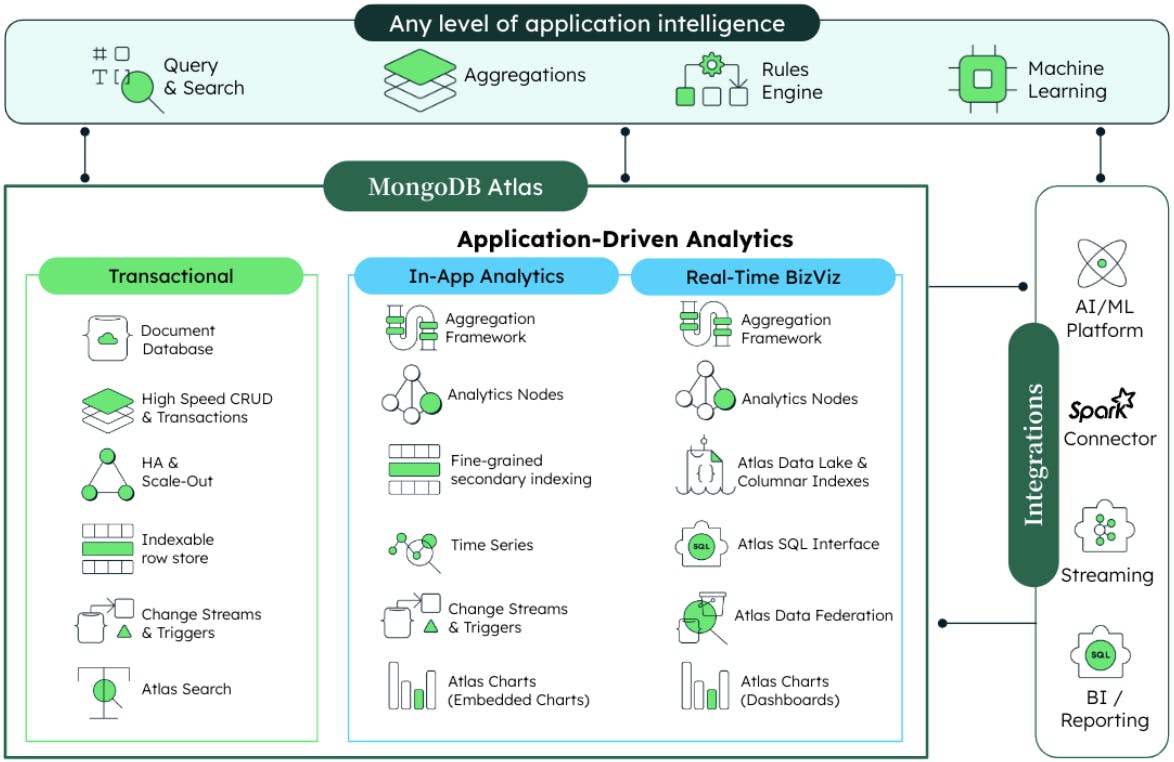Application-Driven Analytics: Why are Operational and Analytical Workloads Converging?
May 8, 2023 | Updated: July 15, 2025
Fifteen years ago, our vision was to provide developers a new approach to databases. As industry change is constant, we are working to bring you another shift so you can stay ahead of the curve – application-driven analytics.
Application-driven analytics isn’t about replacing your centralized data warehouse or data lakehouse. Rather it’s about augmenting them; bringing a new class of analytics directly into applications where they are built by developers.
In his recent Analyst Perspective, Matt Aslett, VP & Research Director at Ventana Research was very clear there remains different functional requirements for dedicated operational and analytical systems. However, he noted the growth in intelligent applications infused with the results of analytic processing. This in turn is driving operational / OLTP data platforms such as MongoDB to integrate native analytics functionality.
In the Perspective, Aslett goes on to describe some of the recent product enhancements introduced by MongoDB to support analytics, and wraps up with this advice:
I recommend that organizations evaluating potential database providers for new, intelligent operational applications include MongoDB Atlas in their evaluations.
If you are interested in learning more about Ventana Research’s insights, take a look at the company’s Analyst Perspective: MongoDB’s Atlas Delivers Data-Driven Applications.
From manufacturing to retail and finance
Beyond the research from industry analysts, organizations are increasingly working to capture the opportunities presented by application-driven analytics.
Bosch Global Software uses MongoDB at the core of its IoT systems powering automotive, industrial, and smart home use cases. Being able to generate analytics in real time is a key capability of the company’s applications. As discussed in his recent article in The New Stack, Kai Hackbarth, senior technology evangelist at Bosch, talked about the value MongoDB provides:
From my history [of doing this for] 22 years, we never had the capabilities to do this before.
Global retailer Marks and Spencer rebuilt its Sparkes rewards program, moving from a packaged app to an in-house solution with MongoDB. The company reduced its time to build one million personalized customer offers from one hour to just five minutes. It is now able to serve those offers at 10x lower latency with the loyalty program driving 8x higher customer spend.
As part of its digital transformation initiative, Toyota Financial Services built a new operational data layer powered with MongoDB Atlas. The data layer connects the company’s internal mainframe backend systems with customers engaging the company through new digital channels. MongoDB handles customer onboarding along with fraud prevention.
The native OLTP and analytics capabilities provided by MongoDB Atlas were key. They eliminated the need for Toyota Financial Services to integrate and build against separate database, cache, object store, and data warehouse technologies. All dramatically simplifying the company’s technology estate.
MongoDB helps us make better decisions and build better products.
Ken Schuelke, Division Information Officer, Toyota Financial Services
Enabling developers for application-driven analytics
How is MongoDDB helping developers make the shift to smarter apps and intelligent software?
MongoDB Atlas unifies the core transactional and analytical data services needed to deliver app-driven analytics. It puts powerful analytics capabilities directly into the hands of developers in ways that fit their workflows. With Atlas, they land data of any structure, index, query, and analyze it in any way they want, and then archive it. All while working with a unified API and without having to build their own data pipelines or duplicate data.
MongoDB Atlas supports any level of application intelligence. From querying and searching records to aggregating and transforming data through to feeding rules-based engines and machine learning models.

Atlas automatically optimizes how data is ingested, processed, and stored, maximizing the efficiency of the application’s operational and analytical workloads. These capabilities are packaged in an elegant and integrated multi-cloud data architecture.
Getting started
There are many ways you can get started in building more intelligent apps. If you want to read more about the use-cases and business drivers, download our App-Driven Analytics whitepaper.
Alternatively if you want to dive straight in, sign up for an account on MongoDB Atlas. From there, they can create a free database cluster, load your own data or our sample data sets, and explore what’s possible within the platform. The MongoDB Developer Center hosts an array of resources including tutorials, sample code, videos, and documentation organized by programming language and product.